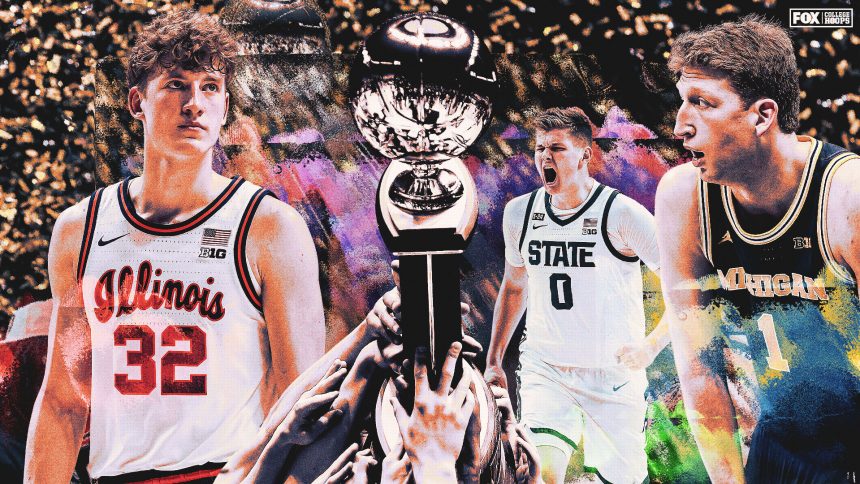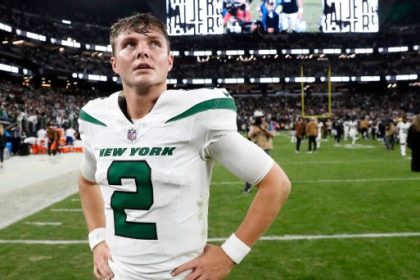Big Ten men’s basketball is in a strong position to receive double-digit bids to the 2025 NCAA Tournament as the league currently boasts 11 teams in the top 35 of the NET rankings. This league is deep, and while the SEC has the top collective résumé in the country with six teams in the Associated Press Top 10, the Big Ten will be America’s second-best conference this season in the category of NCAA Tournament bids, which is the name of the game in college basketball.
Yes, the Big Ten has not won a national championship since 2000, and that drought is a talking point every time a team from the conference reaches the Big Dance. But it shouldn’t take away from the fact that this is a conference with six teams ranked inside both my Top 25 rankings and the AP Top 25 Poll, and several of those teams could make a deep run in March.
The 18-team Big Ten Conference will take center stage this weekend with multiple must-see matchups, including a FOX Primetime Hoops showdown between Indiana and Iowa (8 p.m. ET Saturday on FOX) and a highly-anticipated battle between Michigan State and Northwestern (Noon ET Sunday on FOX).
With that, it felt like a good time to make the case for seven teams that could win the Big Ten regular-season title.
ADVERTISEMENT
Here we go!
TIER A: ILLINOIS, MICHIGAN STATE, MICHIGAN
1. Illinois Fighting Illini (12-3, 4-1)
Why they will win the Big Ten: The Illini are the most talented team in the conference and that was shown last Thursday in the 109-77 beatdown of then-No. 9-ranked Oregon, marking the largest margin of victory by a road team over a top-10 ranked squad in college basketball history. Lithuanian freshman Kasparas Jakucionis is playing like a top-five NBA Draft pick while averaging 16/6/5 per game this season. Croatian big man Tomislav Ivisic is a force on the interior, averaging close to a double-double with 13.9 points and nine rebounds per game. Arizona transfer Kylan Boswell has taken his game to a whole new level for Brad Underwood, who has been exceptional this season, recently giving junior guard Tre White more of an expended role, which has panned out nicely in recent weeks. White has scored in double figures in six of the team’s last seven games, including a pair of 20-point performances over the past week.
This team checks so many boxes on both ends of the floor with a top-20 offense and a top-15 defense, which is a big leap from last year when they were 80th on the defensive end of the floor – and still made the Elite Eight! The Illini also rank second in the country with a rebounding margin of +12.4.
Why they won’t win the Big Ten: They still have road trips to Indiana, Michigan State, Nebraska, Wisconsin and Michigan on the schedule. This team doesn’t have many flaws, but the season is a marathon, and there could be a world where the Jakucionis/Boswell backcourt goes through a lull at some point.
The Illini gave No. 1 Tennessee all they could handle before losing at the buzzer in December. That was still a very encouraging performance, and a reason why I have the Illini in my top 10 this week.
X-factor: Ben Humrichous. The Evansville transfer showed what happens when he’s at his best with a breakout performance of 18 points in the win over Oregon. At 6-foot-9, Humrichous has a smooth shooting stroke, but he did go through some offensive struggles in December. If he can get on track, Illinois has the playmakers in Jakucionis and Boswell to continue to be a top-20 offense in the country.
2. Michigan State Spartans (12-2, 3-0)
Why they will win the Big Ten: The man on the sidelines is a good start to this argument. Now in his 30th season, Hall of Famer Tom Izzo has built a team in his image, as the Spartans rank 11th nationally in KenPom adjusted defensive efficiency while ranking eighth in the country in rebounding margin at +11. This team grinds opponents down defensively for 40 minutes and has the tools to get enough from their offense, which ranks in the top 40 in efficiency.
Senior guard Jaden Akins has figured out that he needs to be Michigan State’s alpha, averaging 16 points per game, while Jaxon Kohler has become one of the Big Ten’s best rebounders, averaging 8.5 boards per game. While perimeter shooting isn’t the strength of this team, they do have several capable 3-point shooters, which gives them a different dimension.
The good news for Michigan State: no road trips to Purdue, Wisconsin or Indiana, three of the most challenging atmospheres in the league, and while the early Los Angeles swing could pose a challenge, it’s not as if Pauley Pavilion or the Galen Center are impossible places to win at.
Depth is a big reason why this team can win the league, as nine Spartans are averaging at least 16 minutes per game on the season.
Why they won’t win the Big Ten: The Spartans go against the grain of modern-day basketball on the offensive end, ranking last in the Big Ten in 3-point percentage at 28%. If Akins were to go through a rut and this team has a spell where their scoring is impacting how they’re defending, it could mean Michigan State drops some games in league play that they are favored in because teams begin to pack it in defensively against them. The key stretch is from Feb. 15-26, when the Spartans are at Illinois and then host Purdue, followed by two more road games at Michigan and Maryland.
X-factor: Jase Richardson, the son of former Spartan and 14-year NBA standout Jason Richardson. The freshman has had three games with multiple 3-pointers this season and that figure needs to continue to rise for a Spartans team in need of shot-making. Shooting 48% from the floor, Richardson possesses good form and changes the game when he’s on the floor because the Spartans have playmakers in Jeremy Fears and Tre Holloman, who are combining for 10 assists per game. While Coen Carr’s explosiveness also swings Michigan State into another gear, the play of Richardson and his confidence continuing to climb is the biggest key to this team having success and making a deep run in March.
3. Michigan Wolverines (12-3, 4-0)
Why they will win the Big Ten: The Wolverines have the ultimate mismatch duo in Danny Wolf and Vlad Goldin and a first-year head coach in Dusty May, who has been an instant program-changer in Ann Arbor. Wolf, the 7-foot junior who transferred in from Yale, is averaging a double-double for the Wolverines, along with four assists per game. His multifaceted skill set is really difficult to defend and when coupled with a 7-1 monster in Goldin, who followed May from Florida Atlantic to Ann Arbor, it makes for a unique combo that is really difficult to defend. We saw that formula in Tuesday’s 92-73 statement win over UCLA as Golden exploded for a career-high 36 points while Wolf tallied 12 points, eight rebounds and six assists as the Wolverines torched a top-five KenPom defense.
But Michigan’s strong start to the year goes beyond the big men. The Wolverines’ backcourt has evolved between Auburn transfer Tre Donaldson, Ohio State transfer Roddy Gayle, and returnee Nimari Burnett. When you can have three guards all averaging over three assists per game and shooting close to 37% from 3-point range on the year, it makes for a winning formula. The Wolverines possess good balance along with a top-20 defense.
Outside a game at Purdue, Michigan’s road slate is not too bad. The Wolverines go to Minnesota, Rutgers, Indiana, Ohio State, Nebraska and Michigan State to close the year. I’ve seen far worse road slates, and this team has already won at the Kohl Center.
Why they won’t win the Big Ten: Turnovers. The Wolverines’ three non-conference losses came by a combined five points in heartbreaking fashion and the common theme was their lack of ball security at key moments. Michigan is currently dead last in the Big Ten in turnover margin, averaging over 15 giveaways per game and coming in at -1.29. The Wolverines have to play cleaner in close games because that’s what a conference regular-season race could come down to, especially in hostile road atmospheres.
X-factor: Nimari Burnett. While the senior is the team’s fifth-leading scorer and was one of the few impact returnees after the coaching change, his production from the perimeter is important for Michigan and typically equates to wins. The Wolverines are 9-1 in games that Burnett hits multiple 3-pointers, with the 6-5 guard drilling a combined 13 trifectas in four games from Dec. 22-Jan. 7. As much as Wolf and Goldin put pressure on opposing frontcourts, it’s Burnett who can be a real game-changer. He had 17 points in Tuesday’s win over UCLA.
TIER B: PURDUE, WISCONSIN
1. Purdue Boilermakers (11-4, 3-1)
Why they will win the Big Ten: Braden Smith is still one of the best players in college basketball, coming in at third in the country with 8.6 assists per game while averaging 15.4 points and 4.8 rebounds per contest. With Smith on the floor and at his best, Purdue can compete with almost every team in the country.
The other differentiator for Matt Painter’s team is Mackey Arena, where the Boilermakers are 8-0 this year and went 16-0 last season. That building is as tough as any homecourt in college basketball and good for 6-10 additional points every time Purdue steps on the floor there.
With Smith and Fletcher Loyer, Painter has a 1-2 punch on the perimeter, but the evolution of Trey Kaufman-Renn is also why the Boilers can be in the Big Ten title race. The junior has evolved into one of the best scorers in the league, averaging 17.8 points, 6.3 rebounds and 2.3 assists per game while shooting 60% from the floor.
Why they won’t win the Big Ten: There’s just not enough assistance beyond the three-headed monster of Smith, Loyer and Kaufman-Renn. As talented as the trio is, the next highest scoring average on the team comes from sophomore Myles Colvin at 6.1 points per game. Between the amount of ball pressure that Smith and Loyer get from opposing defenses and the lack of an additional perimeter scorer who can make the defense pay when they press, it’s a concern for the Boilers, particularly when they get to the NCAA Tournament.
Over the last seven games, Purdue visits Michigan, Michigan State, Indiana and, in the season finale, Illinois. That’s a series of tall tasks in February and early March.
X-factor: It has to be Colvin, whose putback against Ole Miss back in November at the Rady Children’s Invitational gave Purdue an 80-78 victory at the buzzer and pushed the sophomore to a career-high 20-point performance. It’s a small sample size, but the Boilers are 5-1 when the 6-5 guard from Indianapolis scores seven or more points. If Smith and Loyer get any help from the outside, it could change the complexion of this team.
2. Wisconsin Badgers (12-3, 2-2)
Why they will win the Big Ten: Greg Gard has one of the best offenses in college basketball and possesses two guys who can go out and score 30 on any given night. John Tonje and John Blackwell are averaging 18.4 points and 15.8 points per game, respectively, driving the Badgers to a 2-2 start in the league. This team can improve to 4-2 provided they get past Minnesota and a scuffling Ohio State team in their next two games at home. But this Badgers squad can play through either Tonje or Blackwell, and they can get hot in a hurry from downtown with close to 10 made 3s per game, ranking third in the Big Ten.
The Badgers’ schedule is manageable with home games against Illinois, Oregon and Indiana. They do have to head to Mackey Arena, as well as the Breslin Center to meet Michigan State on March 2, but they get the benefit of playing Minnesota twice on the conference slate, closing with the Gophers before hosting Penn State on Senior Day. If they can win one of those marquee road games, the Badgers will be in the mix.
Why they won’t win the Big Ten: The Badgers are third-to-last in the league in defense, allowing over 71 points per game, while also ranking in the back half of the conference in rebounding. While they possess two terrific offensive weapons in Tonje and Blackwell, they don’t have an overwhelming point guard, and Steven Crowl is up and down in terms of scoring on the interior. It’s a good offensive team, but the lack of that constant post presence can sometimes lead the Badgers to some tougher looks and the defense does give up open looks and dribble penetration.
X-factor: Sophomore Nolan Winter, who has been showing some nice progress as of late by scoring 18 or more points in three of the Badgers’ last four games. The 6-11 big man is also averaging 8.3 boards in that span. If Wisconsin can keep him as involved as he’s been as of late, in addition to Tonje and Blackwell, watch out. This team could be right in the conference title mix and could make the program’s first Sweet 16 since 2017.
TIER C: Oregon, Indiana
1. Oregon Ducks (13-2, 2-2)
Why they will win the Big Ten: It might be a bit insulting to have a 13-2 Ducks team in the third tier, but they already own two conference losses and both have come at home. How can they win the Big Ten? By getting the same level of play from Jackson Shelstad that he delivered on Sunday in an 83-79 win over Maryland. The sophomore guard took on the alpha role, delivering 23 points and shooting 5-of-5 from downtown.
For an Oregon team that does not have a guard averaging more than 12 points per game, this offense has a top 25 efficiency rate, but it’s difficult at times when you don’t have that main perimeter scorer. It can’t just be the Nate Bittle show on the interior. As good as the big man has been, with 13.4 points and 8.1 rebounds per game, he can’t always shoulder the scoring in a league with other quality big men that can negate him.
Why they won’t win the Big Ten: The defensive struggles that we saw against Illinois last week were pretty discouraging. The Ducks are susceptible to drive-and-kick 3s, ranking in the back half of the league in perimeter defense, which could hold them back.
Oregon’s backcourt has also been inconsistent throughout the season. Seniors Keeshawn Barthelemy and TJ Bamba have been too hit-or-miss at times, which has led to Oregon’s perimeter offense being a big question.
X-factor: I feel like a broken record, but it has to be Shelstad and Barthelemy, and whether they can start to take off as a consistent perimeter duo. Have they been bad? No, but it feels like it’s been a work in progress. We saw Barthelemy put together a consistent stretch of basketball earlier this season and score 22 points in the Players Era Festival title game victory over Alabama, but he had been quiet in the four games leading up to Maryland.
2. Indiana Hoosiers (13-3, 4-1)
Why they will win the Big Ten: You can’t deny this team’s talent level and that’s been seen by a 4-1 start to conference play, which puts them in the mix. Why can they win the league? Well, if Mike Woodson admits the fact that this team is best with four guards and one big man and plays Oumar Ballo and Malik Reneau separately, then yes, Indiana will be one tough out.
Ballo has been playing like one of the best big men in America as of late, averaging 22 points and 11 rebounds per game over the last three contests. First-round NBA Draft prospect Mackenzie Mgbako, who is averaging 13.2 points per game, is a great shooter and playmaker. Luke Goode gives this team a leader and a perimeter shooter, and on his best day, Myles Rice is on par with any point guard in this league.
Again, Indiana has the talent, but when Reneau is back from injury, the Hoosiers have to play one big at a time. It’s for the best for their spacing.
Why they won’t win the Big Ten: They continue to play with two big men at the same time, which can lead to the offense becoming more clunky and result in more defensive lapses.
The other reason why this team could go in the other direction is if Ballo is in foul trouble or inconsistent. They brought in the Arizona transfer to be an elite big man, which he has been in recent weeks. That has to continue.
A lack of 3-point shooting could also be an issue for this team, as they rank 15th out of 18 with just 6.4 made triples per game, not to mention a negative turnover margin. Rice has to be in command and keep the Hoosiers’ offense on track. The defense ranks in the top 50 of KenPom, so that’s not a heavy concern.
X-factor: Myles Rice and Luke Goode, for different reasons. Rice’s ability to initiate the offense and create for others in this Hoosiers system is pivotal to their success, but he’s averaging 2.5 turnovers per game. The Washington State transfer has had some ups and downs, but he is tasked with so much and is so important to the operation.
Goode’s leadership is going to be critical for this team to get to the NCAA Tournament. When he can supply some perimeter shooting (29 points in three games from Dec. 29-Jan. 5), anything from beyond the arc changes the trajectory of Indiana.
John Fanta is a national college basketball broadcaster and writer for FOX Sports. He covers the sport in a variety of capacities, from calling games on FS1 to serving as lead host on the BIG EAST Digital Network to providing commentary on The Field of 68 Media Network. Follow him at @John_Fanta.
[Want great stories delivered right to your inbox? Create or log in to your FOX Sports account, follow leagues, teams and players to receive a personalized newsletter daily.]
recommended

Get more from College Basketball Follow your favorites to get information about games, news and more










